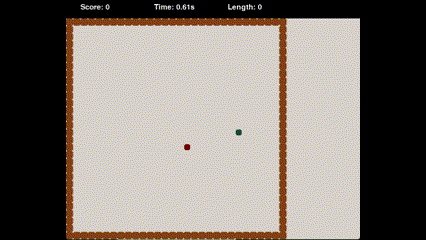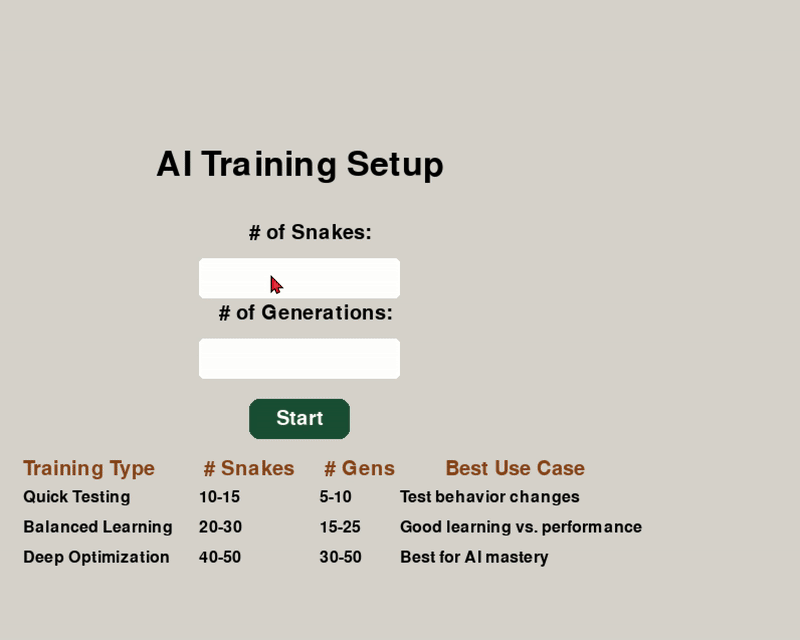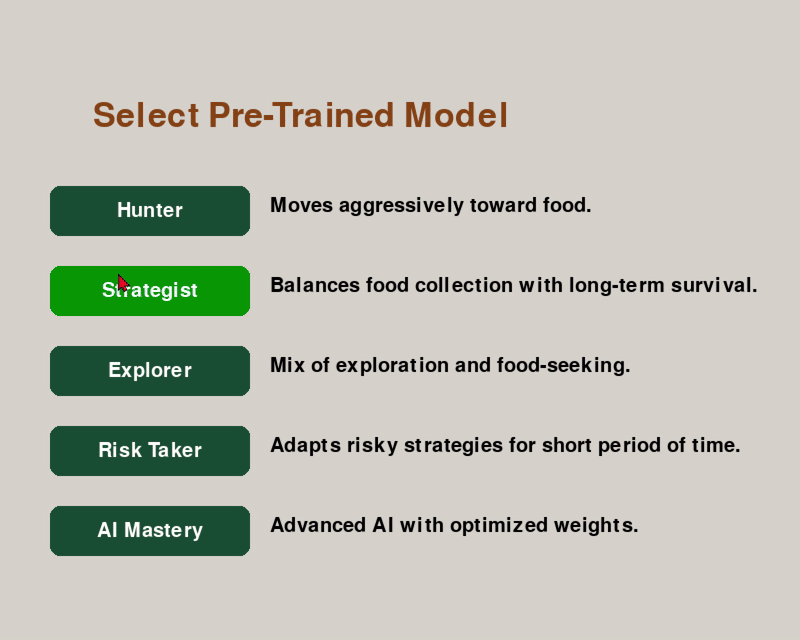Training an AI to Play Snake Using a Genetic Algorithm
🎮 Introduction
With the rapid progress of AI, mainstream attention has shifted to large language models and neural networks — leaving some older but still powerful methods in the shadows. One such method is the Genetic Algorithm (GA) — a fascinating AI technique inspired by biological evolution and survival of the fittest.
To rediscover its potential, I applied a genetic algorithm to a niche but well-defined task: training an AI to play the classic Snake game. This project aimed to optimize snake performance, increase survival time, and visualize the learning process of a GA in a self-contained environment.
🧠 Why Genetic Algorithms?
Unlike traditional models that generalize across tasks, genetic algorithms are tailored for specific environments. They work by evolving a population of candidate solutions (or “snakes”) over generations, gradually improving their performance through selection, crossover, and mutation.
Snake is the perfect game for this: it has a finite action space (Up, Down, Left, Right), a clear objective (eat food and survive), and a well-defined environment. It’s also easy to visualize, making it an ideal playground for evolutionary AI.
🕹 Game Overview
The Snake Gen project, developed in Python 3.11.7 using Pygame, supports three main modes:
- 🧑💻 Manual Mode: Play Snake yourself with arrow keys.

- 🤖 AI Training Mode: Train an AI snake using genetic evolution.

- 🧠 Pre-Trained AI Mode: Watch distinct AI personalities in action (Hunter, Explorer, Strategist, Risk Taker, and AI Mastery).

The interface includes real-time metrics, colorful graphics, and interactive menus.
🔬 Inside the AI Brain
The snake’s AI is powered by a set of 9 weighted parameters representing its “genome”:
- 1- Food Bonus
- 2- Toward Food Reward
- 3- Away From Food Penalty
- 4- Loop Penalty
- 5- Survival Bonus
- 6- Wall Penalty
- 7- Exploration Bonus
- 8- Momentum Bonus
- 9- Dead-End Penalty
Each AI candidate starts with random weights, normalized for stability:
self.brain = np.random.uniform(-1.5, 1.5, 9)
self.brain /= np.linalg.norm(self.brain)
These weights are used in a fitness function to guide decision-making during gameplay.
🧬 The Genetic Algorithm in Action
🔁 Evolution Steps:
- Tournament Selection: Randomly selects a group of snakes and picks the one with the highest fitness.
- Crossover: Combines two parents’ weights at a random cut point.
- Mutation: Applies slight random changes to weights to maintain diversity.
Fitness is evaluated with this formula:
Fitness = (Score × Length × 5) + (Survival Time × 10) - (Moves Made / (Score + 1))
📈 Training Results
The game was trained for 100 generations with 50 candidates per generation. The evolution was clearly visible:
| Generation | Avg. Length | Best Length |
|---|---|---|
| 1 | 6 |
12 |
| 10 | 34 |
72 |
| 50 | 44 |
106 |
| 100 | 63 |
143 |
With each generation, the snakes got better at avoiding walls, finding food, and surviving longer.
🧪 Technical Challenges & Limitations
While effective in defined environments, genetic algorithms are not general-purpose solvers. Their success depends heavily on:
- Carefully chosen state space parameters
- Well-tuned fitness functions
- A simple, structured environment
Transferring trained models to new games or settings is impractical without redesigning the entire setup. However, this specialization is also a strength: it allows for deep optimization in tasks like Snake.
🤖 Ethical Considerations
AI in games often sparks controversy — are bots ruining the experience or creating new forms of expression?
- 🎮 Bad Use: Cheating in online games with unfair advantages.
- 🎮 Good Use: Tool-assisted speedruns (TAS) that push games to their limits.
Like high-frequency trading in finance, intelligent systems need ethics and boundaries. In this project, the goal was exploration and learning — not competition.
✅ Try It Yourself
Clone the repo and start evolving your own snakes:
git clone https://github.com/burakkagann/Snake_Gen
cd Snake_Gen
pip install -r requirements.txt
python Snake-Gen-v11.5.py
References
- 1- Alam, Tanweer, et al. “Genetic Algorithm: Reviews, Implementations, and Applications.” International Journal of Engineering Pedagogy, 2020. arXiv, https://doi.org/10.48550/arXiv.2007.12673
- 2- Bialas, Piotr. pp. 42–46, Implementation of Artificial Intelligence in Snake Game Using Genetic Algorithm and Neural Networks.